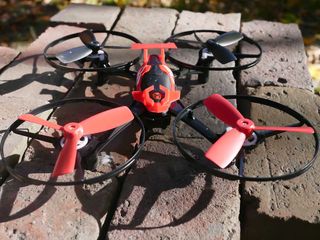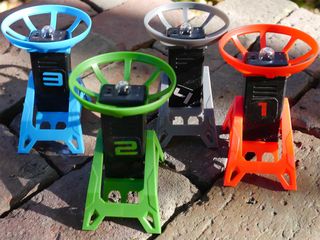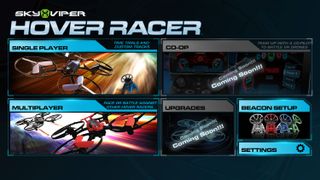Sky Viper Hover Racer Drone Review
The Sky Viper Hover racer is a simple racing drone that offers a lot of performance for a low price.
Why you can trust Tom's Guide

The Sky Viper Hover Drone is a racing drone, but with a twist. Available for about $90, It comes with four beacons that the drone can detect. Place these around your flying field and you've created an impromptu racing track. A companion app records when the beacons are detected. The combination of drone, beacons and the free app allows you to time races or create an obstacle course that the drone has to navigate. If you have more than one Hover Drone, it also creates power-ups and power-downs that you can use on your opponents, Mario Kart-style. It's a fun spin on the idea of drone racing, and the Hover Drone is a simple drone to fly.
Design
The Hover Drone itself is a medium-size quadcopter, measuring about 11 x 10.5 x 3 inches. It's mostly made of black plastic with some colored plastic trim to give the drone a racing look. Four 4-inch, three-blade rotors surround the body, with each rotor surrounded by a plastic ring protecting the blades.
The Hover Drone doesn't feel particularly robust, but it stood up to many crashes and dings in our tests. Two red LEDs light up when the drone is powered on, indicating the back of the craft, but there are no other blink-y lights. It's powered by a small 3.7V, 650mAh lithium polymer battery, which slides into the drone body and can be charged with the included USB cable.

As for the beacons, they're small rectangles a couple of inches tall, with a faux radar dish on top. Set these on the ground and turn them on, and they project an invisible infrared signal that the drone can detect when it flies overhead. After installing the app and connecting it to the drone, the beacons are labeled and remembered by the app, so it knows which beacon the drone is flying over.
MORE: The Best Drones and Quadcopters on Any Budget
Unlike racing drones, such as the Aerix Black Talon, the Hover Drone lacks a forward-facing camera, so you can't get a first-person view of where it's going, and you can't record and replay a video of your flights. Most novice pilots won't miss this feature, even if it is the best way to replay a race and get tips for how to race better. Pilots who are more serious about racing and who want to practice may want to go with the Talon.
You are going to need a lot of AAA batteries to run the Hover Drone's combination of controller and beacons: with three batteries for the remote and two for each of the beacons, you'll use 11 batteries in all. These do last a long time, though: we didn't deplete a full set after several hours of testing.
Specs
Rotors: 4 (3 blades per rotor) replaceable, 4-inch diameter
Battery Size: 3.7V 650-mAh Li-ion, removable
Battery Life: 7/7 minutes (claimed/tested)
Camera: None
Smartphone Controlled: Yes, Android & iOS app
FAA Registration: No
Size:
10.5 by 9.3 by 2 inches
Weight: 3.9 oz
MORE: Why Drone Racing is the Next Big Sport
Controller
The Hover Drone's remote is a small, light game-controller like device, with two control sticks and lots of buttons. Like its video-gaming brethren, the controller also has two shoulder buttons on each side. The front buttons handle power, control sensitivity (with three settings), takeoff and landing, and altitude. The shoulder buttons are for the stunts the drone can do and for triggering the virtual weapons in multiuser mode. The controller connects to the app over Bluetooth, and includes a small holder that will accommodate most small cellphones. (The Nexus 5X I used to test this drone fit snugly.) However, the holder did press on the phone's volume buttons, so I had to place the 5X lopsidedly in the holder.

The other component for controlling the Hover Racer is the Hover Racer App, available for iOS and Android. This free app connects to the controller over Bluetooth and adds a lot of features to the drone. The app can set up time trials where it measures how quickly you can navigate a course between the beacons, competitive races with multiple users or even races with multiple drones if you have them. It's a simple app that adds some interesting new twists to the flying experience and makes things such as competitive races much easier to run. We weren't able to test this, but the app also allows up to four drones to connect and compete directly, and zap each other with virtual weapons, such as speed-ups or laser blasts that aid or hinder other pilots.

SkyViper also offers a flight-simulator app (again for iOS and Android) that can simulate the Hover Racer if you want to get some practice in. The controller is simulated with on-screen controls, but you do get a good feel for the flying experience. It simulates the drone well, including things like the range of the controller and the auto-launch and landing features, plus a series of challenges that teach the fundamentals of drone flying. It's well worth checking out if you want to get some experience before you fly, or practice in bad weather.
MORE: Drone Buying Guide: Everything You Need to Know
Flying
Getting the Hover Drone into the air is simplicity itself: pull the left control stick down, then hold down the Auto Launch button for a few seconds, and the drone takes off and hovers a few feet above the ground. You can raise or lower the height with the altitude buttons, or fly around with the right control stick. The left stick only controls the heading of the drone: In this auto mode, the drone uses a sensor to detect the altitude and keep a certain distance above the ground. When it is time to land, press the same button and the drone gently lands. There is no GPS or return home feature, though: the drone will land wherever it is at the time.
A number of stunt moves are also included, which are started by holding one of the shoulder buttons and moving the right control stick. Stunt moves include a barrel roll, flip and a rather spectacular spiral landing, where the drone spirals downwards dramatically, then lands softly on the ground. Hard-core drone pilots will prefer to fly the Hover Drone in manual mode, which is achieved by holding down the shoulder stunt button and pressing the auto-takeoff button. In this mode, the auto-altitude feature is disabled and the pilot is in full control.
Repairability
The only easily repairable or replaceable part of the Hover Racer is the rotor blades. We found that these didn't need replacing much: the ring that surrounds them protected them in most crashes. The rotors can be removed with a small screwdriver (included with the drone), and a spare set of four is included. An additional set of rotor blades will cost you $9.
MORE: What the FAA's Drone Rules Could Mean for You
Battery Life
The small 650 mAh battery that the Hover Racer uses provides for about 6 to 7 minutes of run time. That's pretty typical for a small drone like this, but it is a little frustrating when trying to do a competitive race where you pass the controller between friends for each to take a turn. (You'll end up having to change batteries every couple of competitors.) Fortunately, the batteries are cheap: you can pick up spares for about $14. Each battery takes about 30-40 minutes to charge with the included USB charging cable, though, so you need to make sure you have a few charged up if you are planning a serious race.
Bottom Line
The Hover Racer is a lot of fun: it flies well for a small drone, with decent speed and turning ability. The auto-takeoff and auto-altitude feature makes it very easy to fly, so novice pilots can focus on learning the basics of flight without worrying about hitting the ground. And the beacons and app-based racing features also make for a lot of fun, as it's easy to set up a track, then race it with a few friends to see who can go fastest. Overall, the Hover Racer is a winner, offering a lot of fun in a well-priced package for the novice pilot and racer.
Sign up to get the BEST of Tom’s Guide direct to your inbox.
Upgrade your life with a daily dose of the biggest tech news, lifestyle hacks and our curated analysis. Be the first to know about cutting-edge gadgets and the hottest deals.
Richard Baguley has been working as a technology writer and journalist since 1993. As well as contributing to Tom's Guide, he writes for Cnet, T3, Wired and many other publications.
